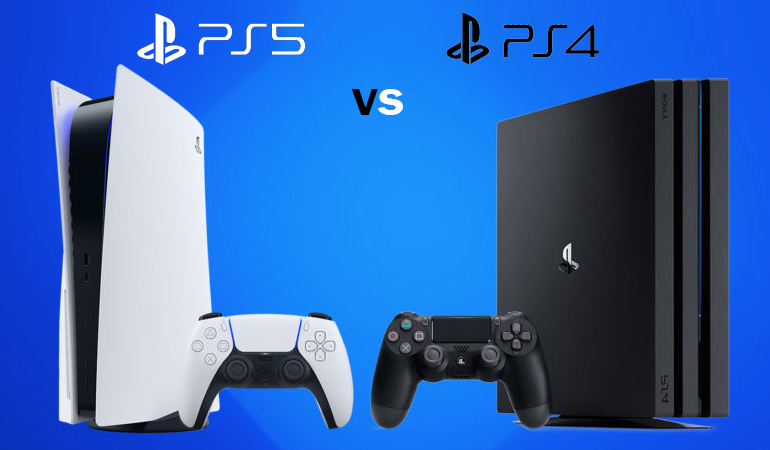Part 1: Introduction
The PlayStation 5 represents the latest generation of gaming consoles from Sony, power by the latest AMD chips and featuring cutting-edge technology. In contrast, the PlayStation 4 originally launched back in 2013 and relies on older hardware that is beginning to show its age against modern games. Let’s take a deeper look at how the internal components of these two consoles compare.

Part 2: Processors
At the heart of the PS5 is an 8-core, 16-thread AMD Zen 2 CPU capable of clock speeds up to 3.5GHz for incredibly fast performance. This allows games to load levels, textures, and enemies nearly instantly compared to previous hardware. It also enables completely new capabilities like 3D spatial audio mixing hundreds of sounds precisely for a fully immersive experience. The PS4 by comparison uses the dated Jaguar CPU architecture from AMD with just 8 cores but lower per-core performance that cannot keep up with modern titles. The PS5’s boosted CPU horsepower unlocks support for resolutions up to 8K along with more complex game logic and physics simulations simply not possible on the PS4’s weaker processor.
Part 3: Graphics Processing
Sony outfitted the PS5 with a custom AMD RDNA 2-based graphics card delivering an enormous 10.28 teraflops of computing power. This allows developers to implement cutting-edge techniques like real-time ray tracing for hyper-realistic lighting and shadow effects. It also provides the grunt required for high-fidelity graphics at 4K and 120 frames per second. The aging PS4 relies on the 18 compute unit Graphics Core Next (GCN) architecture from AMD supplying a mere 1.84 teraflops. While improved in the PS4 Pro, this is still vastly overmatched compared to the PS5’s massively more potent GPU bringing gaming visuals to an entirely new level.
Part 4: Memory
Another crucial component is the console’s system memory. The PS5 comes stocked with 16GB of GDDR6 RAM offering memory bandwidth of 448GB/s. This ultra-fast RAM allows assets to stream seamlessly into action without long load screens disrupting gameplay. Previous generations like the PS4 had to make do with just 8GB of slower GDDR5 memory capping what could be reasonably shown on screen. The PS5 doubles the already substantial memory allotment to satisfy the demands of the largest upcoming AAA blockbuster titles. More breathing room here equates to more immersive living worlds thriving with activity.
Part 5: Storage
Storage speed has become perhaps the most impactful hardware upgrade between PlayStation generations. The PS5 deploys a custom 825GB SSD with up to 5.5GB/s transfers rates assisted by dedicated I/O hardware. This makes it nearly 20 times quicker than the standard 2.5-inch hard disk drive in the PS4 managing 100MB/s at best. As a consequence, boot times, level streaming and asset loading have been minimized down to mere seconds. Players can now seamlessly transition from one gameplay sequence into another without enduring lengthy waits. The PS4’s aging mechanical drive by contrast often induced painful buffering that severed immersion. Solid-state technology has removed this pain point entirely for the new standard in convenience.
Part 6: Backward Compatibility
While no console can play media from all prior generations due to architectural changes, the PS5 aims to maintain a degree of hardware familiarity. It can natively run the overwhelming majority of PS4 titles through backward compatibility. This allows existing 4K libraries to be carried forward for continued enjoyment. The original PS4 on the other hand offered no such compatibility for the massive PS3/PS2/PS1 game collections. Only select titles got ported. The PS5’s approach provides longevity for investments into PlayStation ecosystems and respects player nostalgia by bringing past favorites into the present. It remains a clear advantage over the closed nature of older consoles like the PS4.
Part 7: Design
Console design trends have undeniably moved towards clean aesthetic lines and minimalism. In this regard the two-tone white and black PS5 represents a sleek futuristic refresh from Sony that will stand out on any entertainment center. It can be positioned either vertically or horizontally to better match different spaces. By contrast the boxy PS4 adhered closely to a more corporate rectangular form common of its time. While efficient and inoffensive, it lacks the eye-catching modern charisma of the newer model. First impressions suggest the PS5 will attract far more attention from observers with its architectural impression. This helps fuel desire and brand perception in living rooms.
Part 8: Picture Quality
Ever-rising HD standards have become the benchmark for today’s home consoles. The PS5 promises support for the highest 8K resolution with variable refresh rates potentially reaching up to 120Hz for silky smooth animation. PS4 Pro brought welcomed 4K capabilities to its installed base but is still restricted to 60Hz output at most. Native 8K Support and higher frame rates combine for a qualitative step up in visual fidelity that can justify larger display adoption along with the PS5. Its superior GPU ensures cutting-edge AAA cross-generation titles like Horizon Forbidden West look spectacularly sharp and responsive well into the 2020s.
Part 9: Verdict
In conclusion, it’s clear the PlayStation 5 is vastly more capable than the aging PlayStation 4 hardware in every measurable way. From blistering SSD speeds to mighty Zen 2 CPU power and Navi graphics heft, it has all the specs needed to energize the industry and innovating gaming for many years to come. However, the PS4 is still a perfectly suitable entry point for those seeking to experience the golden age of the PlayStation 4 library at low cost. But for the ultimate immersion befitting ultra HD home theaters, the future-proofed PlayStation 5 is the logical choice and worthy successor for action-packed storytelling like never before. It delivers a true generational leap for joy and graphics that the PS4 could never hope to replicate.

 A Guide to Visiting Dhaka, Bangladesh As a Foreign Tourist
A Guide to Visiting Dhaka, Bangladesh As a Foreign Tourist